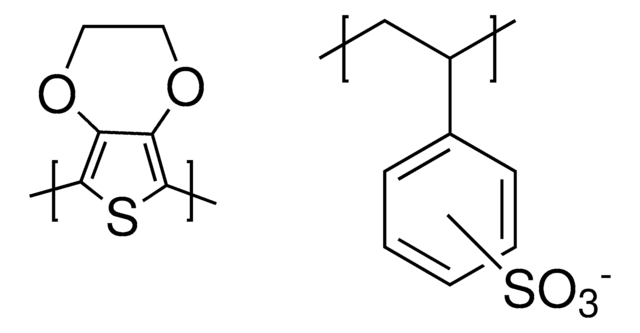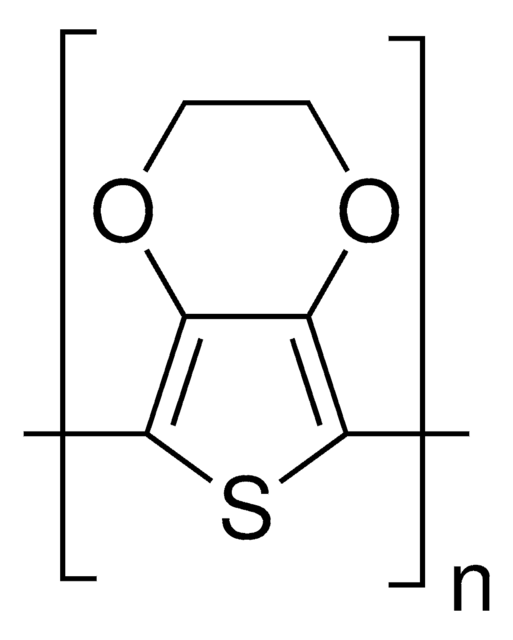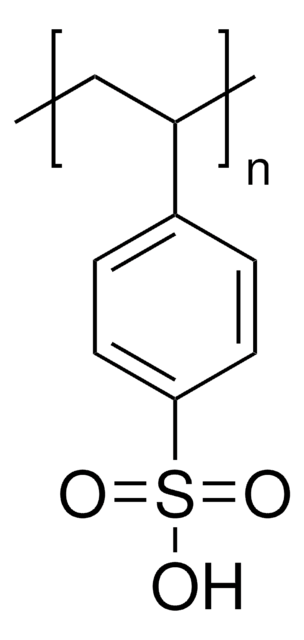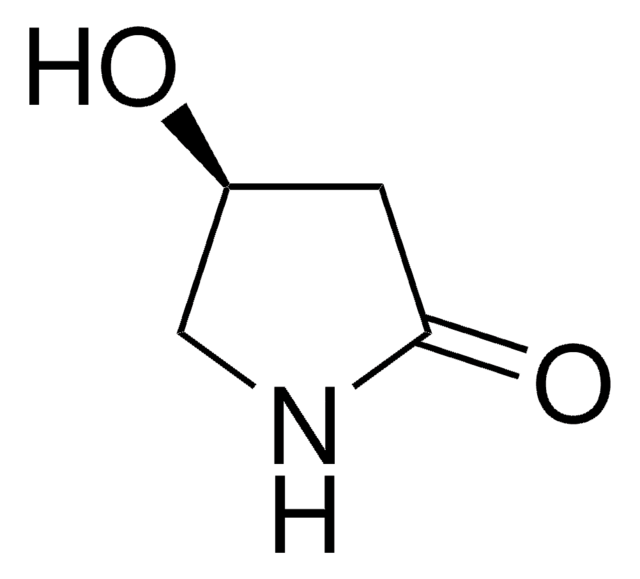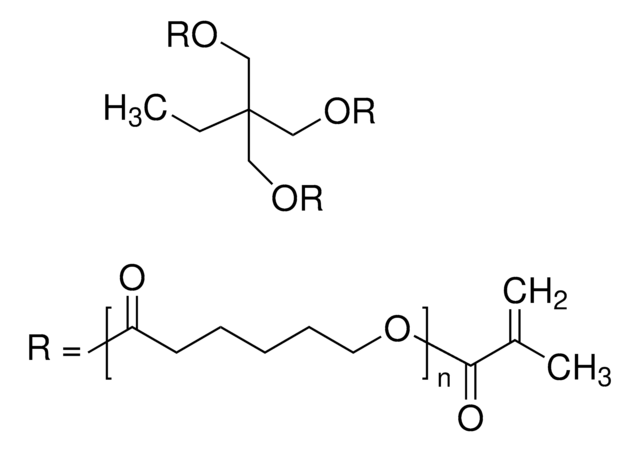483095
PEDOT:PSS
conductive grade, 1.3 wt. % aqueous dispersion
Synonym(s):
PEDOT:PSS, Poly(2,3-dihydrothieno-1,4-dioxin)-poly(styrenesulfonate)
Select a Size
About This Item
Recommended Products
Product Name
Poly(3,4-ethylenedioxythiophene)-poly(styrenesulfonate), 1.3 wt % dispersion in H2O
composition
PEDOT content, 0.5 wt. %
PSS content, 0.8 wt. %
greener alternative product characteristics
Design for Energy Efficiency
Learn more about the Principles of Green Chemistry.
sustainability
Greener Alternative Product
concentration
1.3 wt % dispersion in H2O
band gap
1.6 eV
conductivity
1 S/cm
greener alternative category
storage temp.
2-8°C
Looking for similar products? Visit Product Comparison Guide
1 of 4
This Item | 409510 | 437468 | 799556 |
|---|---|---|---|
| form liquid | form liquid | form liquid | form liquid |
| storage temp. −20°C | storage temp. 2-8°C | storage temp. 2-8°C | storage temp. −20°C |
| density 1.094 g/mL at 25 °C | density 1.099 g/mL at 25 °C | density 1.11 g/mL at 25 °C | density 1.120 at 25 °C |
| mol wt average Mn 800 | mol wt average Mn 550 | mol wt average Mn 750 | mol wt average Mn 950 |
| Quality Level 100 | Quality Level 200 | Quality Level 200 | Quality Level 100 |
General description
Application
Features and Benefits
Packaging
Signal Word
Danger
Hazard Statements
Precautionary Statements
Hazard Classifications
Eye Dam. 1 - Skin Corr. 1
WGK
WGK 2
Personal Protective Equipment
Choose from one of the most recent versions:
Certificates of Analysis (COA)
Don't see the Right Version?
If you require a particular version, you can look up a specific certificate by the Lot or Batch number.
Already Own This Product?
Find documentation for the products that you have recently purchased in the Document Library.
Which document(s) contains shelf-life or expiration date information for a given product?
If available for a given product, the recommended re-test date or the expiration date can be found on the Certificate of Analysis.
How do I get lot-specific information or a Certificate of Analysis?
The lot specific COA document can be found by entering the lot number above under the "Documents" section.
How do I find price and availability?
There are several ways to find pricing and availability for our products. Once you log onto our website, you will find the price and availability displayed on the product detail page. You can contact any of our Customer Sales and Service offices to receive a quote. USA customers: 1-800-325-3010 or view local office numbers.
What is the Department of Transportation shipping information for this product?
Transportation information can be found in Section 14 of the product's (M)SDS.To access the shipping information for this material, use the link on the product detail page for the product.
Is this PEDOT:PSS, poly(3,4-ethylenedioxythiophene)-poly(styrenesulfonate), product p-doped or n-doped?
This PEDOT:PSS product is based on hole-doped or P-type polymers. PEDOT can be n-doped, but the materials are too unstable to be of any commercial value.
What is the temperature stability of this poly(3,4-ethylenedioxythiophene)-poly(styrenesulfonate), PEDOT:PSS, product?
Deposited poly(3,4-ethylenedioxythiophene)-poly(styrenesulfonate), PEDOT:PSS, films can easily withstand temperatures in excess of 200°C for short duration and around 70°C in continuous service. The aqueous dispersions of PEDOT:PSS, however, can be damaged by heating above 50°C for a prolonged period.
How do I test the coductivity of poly(3,4-ethylenedioxythiophene)-poly(styrenesulfonate), PEDOT:PSS?
Conductivity measurements should be performed on poly(3,4-ethylenedioxythiophene)-poly(styrenesulfonate), PEDOT/PSS, films deposited on flat substrates. This dispersion should be deposited as a thin and homogeneous layer on a flat substrate using deposition techniques, such as spin-coating or doctor blading. The layer thickness can be determined by scratching the film off the substrate in places with a razor blade and scanning the stylus of a mechanical or optical profilometer across the scratched region(s). The sheet resistivity can then be measured with conventional four-point probes.
Can PEDOT:PSS, Poly(3,4-ethylenedioxythiophene)-poly(styrenesulfonate), coatings be etched?
Yes, applied PEDOT:PSS films can be patterned by laser ablation.
My question is not addressed here, how can I contact Technical Service for assistance?
Ask a Scientist here.
Articles
Lithography, based on traditional ink-printing techniques, is a process for patterning various layers, such as conductors, semiconductors, or dielectrics, on a surface.
In the field of organic printable electronics, such as OLEDs and organic photovoltaics (OPVs), improved organic conducting and semiconducting materials are needed. The progress in two fields is reviewed in this article.
Conducting polymers such as polyaniline, polythiophene and polyfluorenes are now much in the spotlight for their applications in organic electronics and optoelectronics.
Advancements in bioelectronics, incorporating self-healing materials for wearable devices, and measuring bioelectric signals to assess physiological parameters.
Our team of scientists has experience in all areas of research including Life Science, Material Science, Chemical Synthesis, Chromatography, Analytical and many others.
Contact Technical Service
